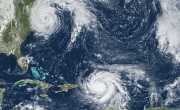Autumn 2016 | As visitors to the DTC in 2015, Jason Otkin, Chris Rozoff, and Sarah Griffin explored using object-based verification methods to assess the accuracy of cloud forecasts from the experimental High Resolution Rapid Refresh (HRRR) model. Though the forecast accuracy could be assessed using traditional statistics such as root mean square error or bias, additional information about errors in the spatial distribution of the cloud field could be obtained by using more… Read More
Community Connections: WRF Users' Workshop - June 2017

Autumn 2017 | The first Weather Research and Forecasting model (WRF) Users’ Workshop was held in 2000. Since then, eighteen annual workshops have been organized and hosted by the National Center for Atmospheric Research in Boulder, Colorado to provide a platform where developers and users can share new developments, test results, and feedback. This exchange ensures the WRF model continues to progress and remain relevant. The workshop program has evolved through the years. In 2006, instructional sessions were introduced, with the first… Read More
Community Connections: The 2014 GSI Community Tutorial
GSI review Committee Meeting
Autumn 2014 | The DTC hosted the 5th Community Gridpoint Statistical Interpolation (GSI) Tutorial on July 14-16 of this summer at the NCAR Foothills Laboratory in Boulder, Colorado. One of several outreach events sponsored recently by the DTC, this tutorial was held in collaboration with other major GSI development teams from around the United States. With an ultimate goal of providing operational capabilities to the research community, this series of tutorials has become a primary training resource whereby both operational and… Read More
Did you know?: A single column model (SCM) can be an easy, quick, and cheap way to test new or updated physics schemes
Autumn 2017 | A SCM replaces advection from a dynamical core with forcing that approximates how the atmospheric column state changes due to large-scale horizontal winds. An atmospheric physics suite then calculates impacts to radiation, convection, microphysics, vertical diffusion and other physical processes as the forcing alters the column state. The SCM approach is conceptually simple, extremely quick to run (less than a minute on a laptop), and makes interpretation of results less ambiguous because it eliminates three-dimensional… Read More
Announcement: News from the DTC
Announcements, Publications and More
Autumn 2014 | Announcements, Publications and More VISITOR PROJECT AWARDS Paul Roebber (Univ of Wisconsin - Milwaukee):Demonstration Project: Development of a Large Member Ensemble Forecast System for Heavy Rainfall using Evolutionary Programming. WORKSHOPS, TUTORIALS, EVENTS Physics Workshop The DTC and NOAA will convene a workshop entitled ‘Parameterization of moist process for next-generation numerical weather prediction… Read More
Lead Story: The need for a Common Community Physics Package
Summer 2016 | While national modeling centers can benefit from the expertise in the broader community of parameterization developers, the social and technical barriers to a community researcher implementing and testing a new parameterization or set of parameterizations (a physics suite) in an operational model are high. Physical parameterization codes are often implemented so that they are strongly linked to a particular model dynamical core, with dependencies on grid structure, prognostic variables, and even time-… Read More
Lead Story: Evaluating WRF performance over time
Autumn 2014 | As modifications and additions are made to WRF code and released to the community, users often ask, “Is WRF really improving?”
Director's Corner: Kevin Kelleher
Kevin Kelleher, NOAA GSD
Autumn 2014 | During my first 15 months as the ESRL Global Systems Division Director, I have learned about the DTC and its role in the modeling community. The DTC has made remarkable gains in supporting the WRF model within the community that has contributed to the great success and usage of the model both nationally and internationally. I believe the DTC is unique in how it is funded and operated as a joint effort between NCAR and NOAA, along with partners from the Air Force. It is my observation that there is a significant effort to… Read More
Who's Who: Kathryn Newman

Autumn 2016 | As a Junior Atmospheric Science major, at the University of North Dakota (UND), Kathryn Newman organized 25 weather labs for hundreds of aviation students that were required to take Meteorology (ATSC 110). The multi-tasking and organizational skills she developed come in handy as the DTC Hurricane Task Lead to oversee transitioning Hurricane Task research to EMC. “It’s challenging to keep track of all the moving parts in modeling research and getting them into operations,” she says, “But it is cool to be involved at this… Read More
Visitors: Harnessing the Power of Evolution for Weather Prediction
Visitor: Paul Roebber
Summer 2016 | As a DTC Visitor in 2015, Paul Roebber explored an idea for generating ensemble weather predictions known as evolutionary programming (EP). The method relies on a gradually and increasingly restrictive cost function to produce and to evaluate succeeding generations of a population of algorithms until such time as a best ensemble solution is determined based on cross-validation. The approach was developed by Roebber to produce baseline prediction equations equivalent to linear or nonlinear multiple regression… Read More
Did you know?: Did you know there are suggested topics for Visitor Projects that receive special consideration?
Autumn 2016 | Advance the forecast skill of the DTC-supported HWRF modeling system through improved physics and/or initialization Advance the analysis capability of the DTC-supported Gridpoint Statistical Interpolation and/or the NOAA Ensemble Kalman Filter (EnKF) Data Assimilation systems through development, testing, and evaluation of advanced data assimilation techniques and the addition of new data types or measurements Transition innovations in atmospheric physical parameterizations to NOAA’s Next-Generation Global… Read More
Software Release: Release v3.9a of the HWRF system
Proposals for Contributions Encouraged

2017-10-16 | The Developmental Testbed Center (DTC) is pleased to announce the release of version 3.9a of the community HWRF modeling system. The release includes all components of the system: scripts, data preprocessing, vortex initialization, data assimilation, atmospheric and ocean models, coupler, postprocessor, and vortex tracker. Both the Scientific Documentation and the Users Guide have been updated.… Read More
Pagination
Copyright © 2024. All rights reserved.